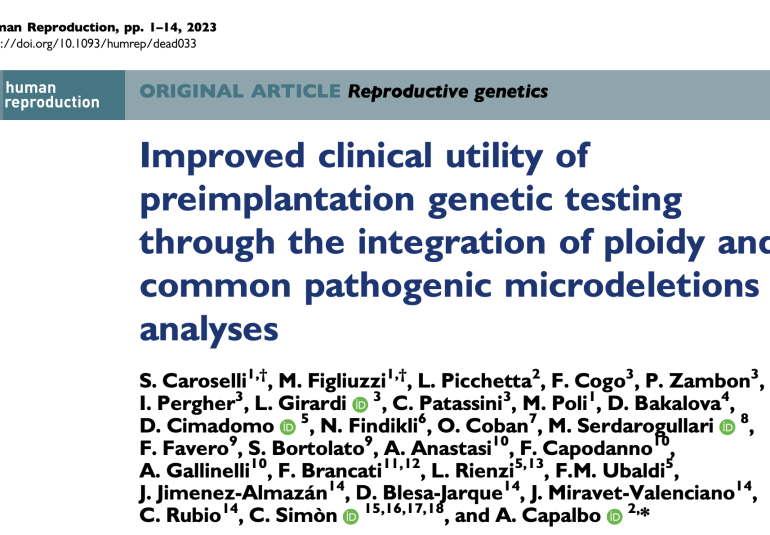
S. Caroselli, M. Figliuzzi, L. Picchetta, F. Cogo, P. Zambon, I. Pergher, L. Girardi, C. Patassini, M. Poli, D. Bakalova, D. Cimadomo, N. Findikli, O. Coban, M. Serdarogullari, F. Favero, S. Bortolato, A. Anastasi, F. Capodanno, A. Gallinelli, F. Brancati11,12, L. Rienzi, F.M. Ubaldi, J. Jimenez-Almaza, D. Blesa-Jarque, J. Miravet Valenciano, C. Rubio, C. Simo, and A. Capalbo
Human Reproduction, 2023 Apr 3;38(4):762-775. doi: 10.1093/humrep/dead033 – Submitted on September 4, 2022; resubmitted on January 28, 2023; editorial decision on February 8, 2023
Abstract
Study question: Can chromosomal abnormalities beyond copy-number aneuploidies (i.e. ploidy level and microdeletions (MDs)) be detected using a preimplantation genetic testing (PGT) platform?
Summary answer: The proposed integrated approach accurately assesses ploidy level and the most common pathogenic microdeletions causative of genomic disorders, expanding the clinical utility of PGT.
What is known already: Standard methodologies employed in preimplantation genetic testing for aneuploidy (PGT-A) identify chromosomal aneuploidies but cannot determine ploidy level nor the presence of recurrent pathogenic MDs responsible for genomic disorders. Transferring embryos carrying these abnormalities can result in miscarriage, molar pregnancy, and intellectual disabilities and developmental delay in offspring. The development of a testing strategy that integrates their assessment can resolve current limitations and add valuable information regarding the genetic constitution of embryos, which is not evaluated in PGT providing new level of clinical utility and valuable knowledge for further understanding of the genomic causes of implantation failure and early pregnancy loss. To the best of our knowledge, MDs have never been studied in preimplantation human embryos up to date.
Study design, size, duration: This is a retrospective cohort analysis including blastocyst biopsies collected between February 2018 and November 2021 at multiple collaborating IVF clinics from prospective parents of European ancestry below the age of 45, using autologous gametes and undergoing ICSI for all oocytes. Ploidy level determination was validated using 164 embryonic samples of known ploidy status (147 diploids, 9 triploids, and 8 haploids). Detection of nine common MD syndromes (-4p=Wolf-Hirschhorn, -8q=Langer-Giedion, -1p=1p36 deletion, -22q=DiGeorge, -5p=Cri-du-Chat, -15q=Prader-Willi/Angelman, -11q=Jacobsen, -17p=Smith-Magenis) was developed and tested using 28 positive controls and 97 negative controls. Later, the methodology was blindly applied in the analysis of: (i) 100 two pronuclei (2PN)-derived blastocysts that were previously defined as uniformly euploid by standard PGT-A; (ii) 99 euploid embryos whose transfer resulted in pregnancy loss.
Participants/materials, setting, methods: The methodology is based on targeted next-generation sequencing of selected polymorphisms across the genome and enriched within critical regions of included MD syndromes. Sequencing data (i.e. allelic frequencies) were analyzed by a probabilistic model which estimated the likelihood of ploidy level and MD presence, accounting for both sequencing noise and population genetics patterns (i.e. linkage disequilibrium, LD, correlations) observed in 2504 whole-genome sequencing data from the 1000 Genome Project database. Analysis of phased parental haplotypes obtained by single-nucleotide polymorphism (SNP)-array genotyping was performed to confirm the presence of MD.
Main results and the role of chance: In the analytical validation phase, this strategy showed extremely high accuracy both in ploidy classification (100%, CI: 98.1-100%) and in the identification of six out of eight MDs (99.2%, CI: 98.5-99.8%). To improve MD detection based on loss of heterozygosity (LOH), common haploblocks were analyzed based on haplotype frequency and LOH occurrence in a reference population, thus developing two further mathematical models. As a result, chr1p36 and chr4p16.3 regions were excluded from MD identification due to their poor reliability, whilst a clinical workflow which incorporated parental DNA information was developed to enhance the identification of MDs. During the clinical application phase, one case of triploidy was detected among 2PN-derived blastocysts (i) and one pathogenic MD (-22q11.21) was retrospectively identified among the biopsy specimens of transferred embryos that resulted in miscarriage (ii). For the latter case, family-based analysis revealed the same MD in different sibling embryos (n = 2/5) from non-carrier parents, suggesting the presence of germline mosaicism in the female partner. When embryos are selected for transfer based on their genetic constitution, this strategy can identify embryos with ploidy abnormalities and/or MDs beyond aneuploidies, with an estimated incidence of 1.5% (n = 3/202, 95% CI: 0.5-4.5%) among euploid embryos.
Limitations, reasons for caution: Epidemiological studies will be required to accurately assess the incidence of ploidy alterations and MDs in preimplantation embryos and particularly in euploid miscarriages. Despite the high accuracy of the assay developed, the use of parental DNA to support diagnostic calling can further increase the precision of the assay.
Wider implications of the findings: This novel assay significantly expands the clinical utility of PGT-A by integrating the most common pathogenic MDs (both de novo and inherited ones) responsible for genomic disorders, which are usually evaluated at a later stage through invasive prenatal testing. From a basic research standpoint, this approach will help to elucidate fundamental biological and clinical questions related to the genetics of implantation failure and pregnancy loss of otherwise euploid embryos.
Study funding/competing interest(s): No external funding was used for this study. S.C., M.F., F.C., P.Z., I.P., L.G., C.P., M.P., D.B., J.J.-A., D.B.-J., J.M.-V., and C.R. are employees of Igenomix and C.S. is the head of the scientific board of Igenomix. A.C. and L.P. are employees of JUNO GENETICS. Igenomix and JUNO GENETICS are companies providing reproductive genetic services.